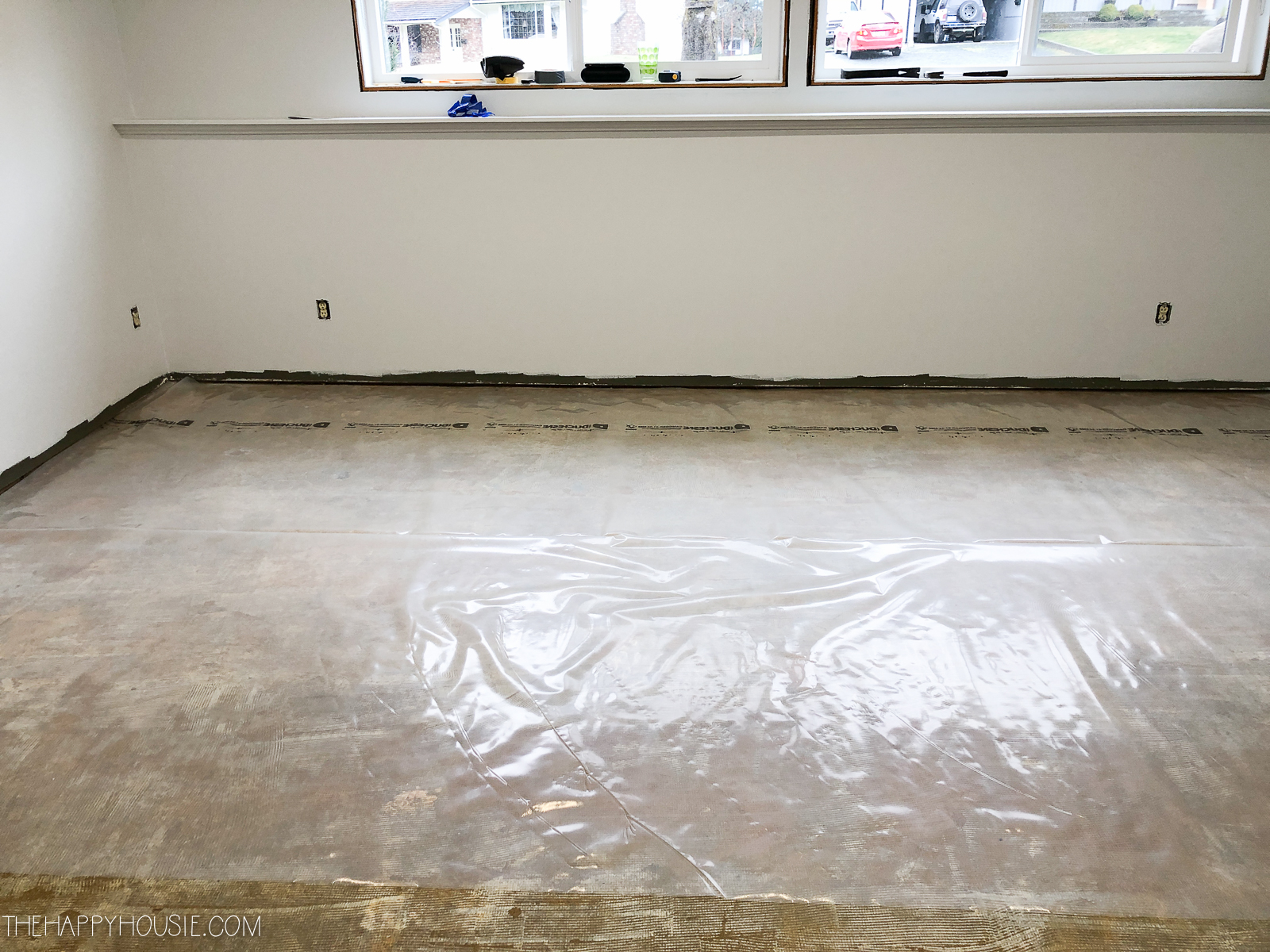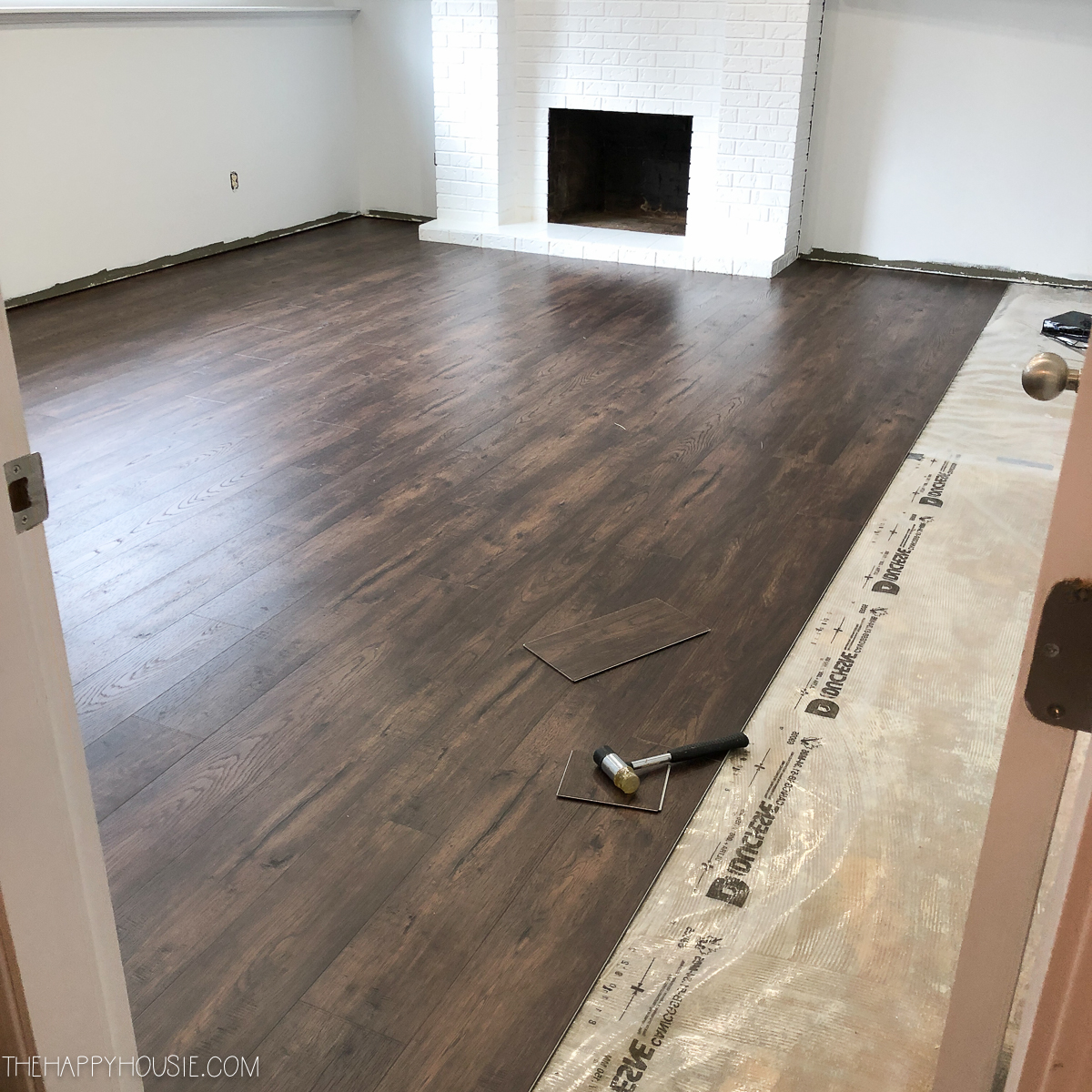Imagine this: you’re finally tackling that outdated concrete basement floor, dreaming of a stylish and practical space. But then, a nagging question pops up: “Can I just lay vinyl flooring directly over the concrete?” It’s a question that’s plagued many a DIY enthusiast, and rightfully so. The answer, as you’ll soon discover, is far more nuanced than a simple yes or no.

Image: dragon-upd.com
This guide delves into the intricacies of installing vinyl flooring over concrete, exploring the critical factors, potential pitfalls, and expert tips to ensure a successful outcome. Whether you’re a seasoned renovator or a first-time homeowner, understanding the ins and outs of this project will empower you to make informed decisions and achieve your desired results.
The Allure of Vinyl Flooring Over Concrete
The allure of vinyl over concrete is undeniable. Vinyl flooring offers a plethora of benefits that make it a popular choice for basement renovations, garages, and even living spaces:
- Versatility: Available in an array of styles, colors, and textures, vinyl can mimic the look of wood, tile, or even stone, offering endless design possibilities.
- Durability: Vinyl is known for its resistance to scratches, dents, and moisture, making it ideal for high-traffic areas.
- Water Resistance: Unlike wood flooring, vinyl is waterproof, making it perfect for damp environments like basements and bathrooms.
- Ease of Maintenance: Vinyl is relatively low-maintenance, requiring regular sweeping and occasional mopping.
- Cost-Effective: Compared to other flooring options like hardwood or tile, vinyl is generally more affordable.
But before you jump headfirst into a vinyl flooring project, it’s crucial to understand the fundamental considerations that determine whether it’s the right choice for your concrete substrate.
The Concrete Factor: A Deep Dive
Concrete, while durable, can present unique challenges when it comes to flooring installations. Factors like moisture levels, unevenness, and the presence of cracks can drastically impact the success of your project. Here’s a breakdown of the key considerations:
1. Moisture: The Silent Enemy
Moisture is the biggest villain in the vinyl flooring game. Excessive moisture trapped beneath the vinyl can lead to:
- Mold and Mildew Growth: Moisture creates a breeding ground for harmful microorganisms that can damage the flooring and compromise indoor air quality.
- Warpage and Deformity: Vinyl flooring is susceptible to warping and buckling when exposed to prolonged moisture.
- Adhesive Failure: Moisture can prevent the adhesive from adhering correctly, leading to loose tiles or planks.
Therefore, it’s imperative to assess the moisture level of your concrete substrate before installing vinyl flooring.

Image: phenergandm.com
How to Test Your Concrete’s Moisture Level:
You can use a moisture meter specifically designed for concrete. Alternatively, you can employ a simple plastic sheet test:
- Lay a piece of clear plastic sheeting (at least 24 inches square) on the concrete floor.
- Secure the edges with tape to prevent air from seeping in.
- Leave the plastic sheet in place for at least 24 hours.
- If condensation forms on the underside of the plastic, it indicates high moisture levels, and you’ll need to address this issue before laying vinyl.
2. Unevenness: A Foundation for Disaster
An uneven concrete surface can wreak havoc on your vinyl flooring installation. High spots can lead to uneven wear and tear, while low spots can cause trip hazards. Additionally, unevenness can make it difficult to lay down a smooth, consistent flooring surface.
How to Level Your Concrete:
For minor imperfections, you can use a self-leveling concrete compound. For larger discrepancies, you may need to consider a more robust leveling solution, potentially involving a concrete grinder or other professional equipment.
3. Cracks: A Threat to Durability
Cracks in the concrete can cause the vinyl flooring to crack or tear over time. As the cracks widen, the seams of the vinyl can become stressed, leading to premature failure.
How to Address Cracks in Concrete:
Cracks can be repaired using a patching compound specifically designed for concrete. If the cracks are extensive or deep, consulting a professional contractor is recommended.
Prepping Your Concrete for Vinyl: The Foundation for Success
Once you’ve assessed the concrete for moisture, unevenness, and cracks, it’s time to prepare it properly for the vinyl flooring installation. This step is crucial for ensuring a long-lasting and aesthetically pleasing outcome:
- Clean the Surface Thoroughly: Remove any loose debris, dirt, dust, grease, or oil with a stiff-bristled broom, vacuum, or damp cloth.
- Apply a Concrete Sealer: A sealant creates a moisture barrier, protecting the concrete and preventing moisture from affecting the vinyl.
- Install a Moisture Barrier: A moisture barrier acts as an extra layer of protection, further safeguarding the vinyl from moisture intrusion. There are various options for moisture barriers, including polyethylene sheeting, vapor retarders, and moisture-resistant underlayment.
Choosing the Right Vinyl Flooring
Now that you’ve prepared the concrete surface, it’s time to select the perfect vinyl flooring to complement your space. Vinyl flooring comes in a variety of options, each with their advantages and drawbacks:
1. Vinyl Tiles
Vinyl tiles offer a traditional look and are ideal for small spaces or for creating intricate patterns. They come in a variety of shapes, sizes, and designs.
2. Vinyl Planks
Vinyl planks mimic the appearance of hardwood flooring, offering a more contemporary aesthetic. They are typically available in lengths of 36 inches or more, creating a seamless look.
3. Luxury Vinyl Tile (LVP)
Luxury vinyl tile (LVP) is a premium option that offers an exceptionally realistic wood or stone appearance, increased durability, and enhanced water resistance. LVP typically utilizes a click-lock installation system for ease of installation.
4. Luxury Vinyl Plank (LVP)
Luxury vinyl plank (LVP) provides a high-end alternative to traditional wood flooring, offering a stylish and durable solution. LVP planks are designed to be thicker and more resilient than traditional vinyl planks, offering superior longevity.
Important Considerations:
- Thickness: Vinyl flooring comes in various thicknesses, ranging from 2mm to 8mm. Thicker options offer greater durability and sound insulation.
- Installation Method: Vinyl flooring can be installed using adhesive, click-lock systems, or a combination of both.
- Wear Layer: The wear layer is the top layer of the vinyl flooring that protects it from wear and tear. Choose a wear layer with a high MIL (mils) rating for increased durability.
Expert Insights and Actionable Tips:
While installing vinyl flooring over concrete might seem like a straightforward project, seeking professional guidance can significantly improve the outcome. Here are some valuable insights from experienced flooring professionals:
- Consult a Professional: Especially if you’re working with a large area, complex layouts, or challenging substrates, consulting a professional flooring installer can minimize potential complications and ensure a successful installation.
- Plan Your Layout Carefully: Measure your space carefully and consider the direction of the flooring planks or tiles to create a visually appealing and functional design.
- Utilize Proper Tools: Having the right tools for the job is essential. Invest in a quality cutting tool, a level, and a kneeler to make the installation process smoother.
Can I Put Vinyl Flooring Over Concrete
Conclusion
Laying vinyl flooring over concrete offers a stylish and practical solution for transforming your home. By carefully assessing your concrete substrate, addressing moisture issues, prepping the surface adequately, and selecting the right vinyl flooring, you can achieve a beautiful and durable finish. Whether you embark on this journey as a DIY project or enlist expert assistance, understanding the nuances of this process will empower you to make informed decisions and create a space you’ll love for years to come.
Have you tackled a vinyl flooring over concrete project before? Share your experiences, tips, and any helpful resources you’ve encountered in the comments below!






